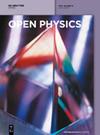Accumulation process in the environment for a generalized mass transport system
IF 1.8
4区 物理与天体物理
Q2 PHYSICS, MULTIDISCIPLINARY
引用次数: 0
Abstract
In last decades, there have been drastic environmental transformations and mutations happening all around the world. Due to the continuous mass transfer process, for example,广义质量运输系统在环境中的积累过程
在过去的几十年里,世界各地都发生了剧烈的环境变化和突变。由于持续的质量传递过程,例如 CO 2 {{\rm{CO}}}_{2} 质量传递,在这种情况下,以温室气体排放的形式,不寻常和极端的现象时有发生,扰乱了我们的生态系统,造成了破坏和混乱。减少或阻止这些气体的排放已成为我们这个星球上的主要话题之一。我们研究了一个描述自然界质量传输过程的数学模型的可解性,其中考虑了额外的扰动参数。除了研究模型的稳定性,我们还利用 Crank-Nicholson 数值方法对模型的收敛性进行了分析,以评估其效率,并进行了一些数值模拟。研究结果表明,该模型的动态特征是有许多分组(累积)区,在这些分组区中,(例如 CO 2 {{\rm{CO}}}_{2} 的)质量以递增的方式累积。这一结果对于控制 CO 2 {{\rm{CO}}{2} 如何储存在我们周围这个日益受到干扰的环境中非常重要。
本文章由计算机程序翻译,如有差异,请以英文原文为准。
求助全文
约1分钟内获得全文
求助全文
来源期刊

Open Physics
PHYSICS, MULTIDISCIPLINARY-
CiteScore
3.20
自引率
5.30%
发文量
82
审稿时长
18 weeks
期刊介绍:
Open Physics is a peer-reviewed, open access, electronic journal devoted to the publication of fundamental research results in all fields of physics. The journal provides the readers with free, instant, and permanent access to all content worldwide; and the authors with extensive promotion of published articles, long-time preservation, language-correction services, no space constraints and immediate publication. Our standard policy requires each paper to be reviewed by at least two Referees and the peer-review process is single-blind.
 求助内容:
求助内容: 应助结果提醒方式:
应助结果提醒方式:


